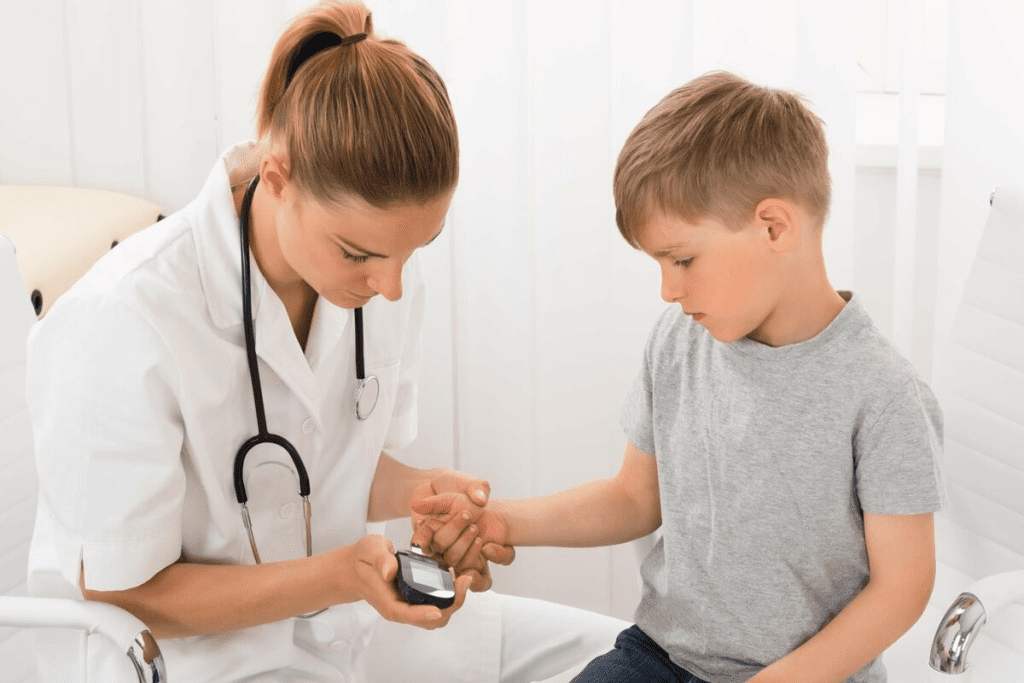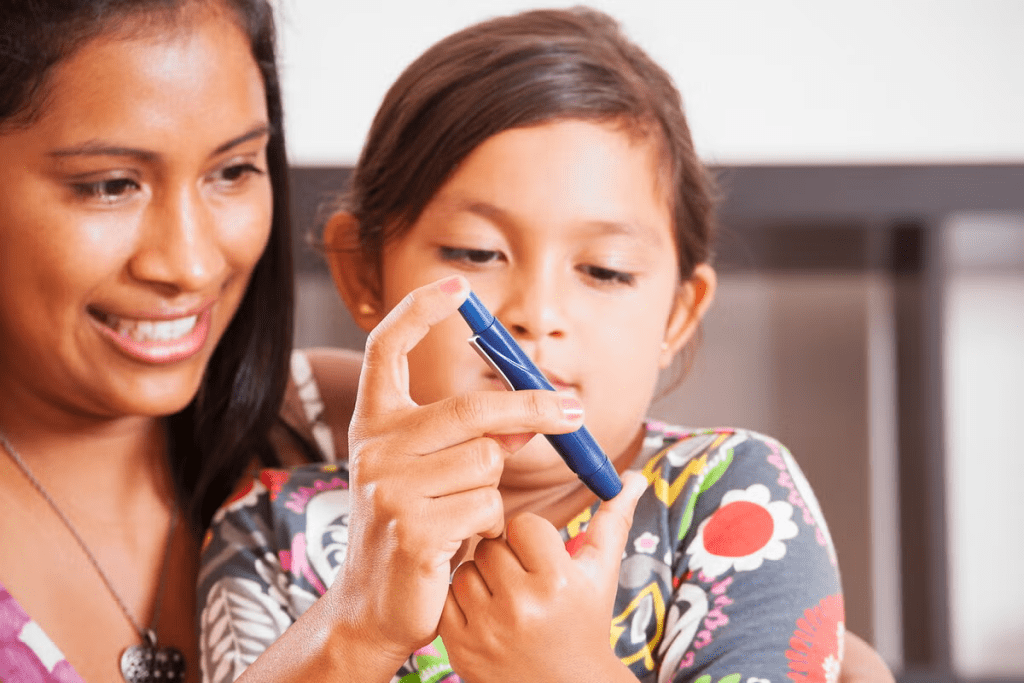Last Updated on November 14, 2025 by
Spotting diabetes in children is key, as symptoms can pop up fast. Look out for signs like more thirst, needing to pee a lot, losing weight without trying, feeling tired, and being easily upset.
The American Diabetes Association says about 352,000 kids under 20 have diabetes. As parents and caregivers, knowing the signs of juvenile diabetes is vital. It helps us catch it early and get help fast.

Type 1 diabetes in children has warning signs. Learn how to know if your child has diabetes and when to seek urgent help.
Diabetes in children has increased a lot in recent years. This worries doctors and parents. It’s important to know about this trend to help manage and prevent serious problems.
The Centers for Disease Control and Prevention (CDC) says about 352,000 kids in the U.S. have diabetes. Every year, 18,000 kids get type 1 diabetes. Type 2 diabetes in kids is also getting more common.
Worldwide, type 1 diabetes cases have gone up by 200%-300% in the last 20-30 years. This is a big concern.
“The rapid increase in childhood diabetes cases is a wake-up call for healthcare systems worldwide.” This shows we need to be careful and take action to stop diabetes in kids.
Finding diabetes early in kids is key to managing it well. Early treatment can greatly improve a child’s life. We must teach parents, caregivers, and doctors to spot diabetes signs early.
By knowing the current numbers and the need for early detection, we can fight childhood diabetes together. This way, kids can get the care they need to do well.
As parents, knowing the early signs of type 1 diabetes is key. Early detection can greatly improve your child’s life with the condition.
Increased thirst and frequent urination are key signs. When glucose levels are high, the body makes more urine. This can cause dehydration and make your child feel very thirsty.
Children with type 1 diabetes may lose weight even if they’re hungry. This happens because their bodies can’t use glucose for energy. So, they start breaking down fat and muscle instead.
Extreme fatigue is a common symptom. Without enough glucose, the body’s cells lack energy. This can make your child feel cranky or moody.
Watch for other signs too:
Spotting these symptoms early is vital. If you see any, get your child to a doctor right away.
Knowing these signs helps you act fast. Early diagnosis and treatment can manage the condition well and prevent serious problems.

Type 1 diabetes is an autoimmune condition that affects many children and their families. It happens when the body’s immune system attacks and destroys the insulin-making cells in the pancreas. This leads to a lack of insulin production.

In a normal body, the pancreas makes insulin. This lets glucose get into cells and give energy. But in children with Type 1 diabetes, the lack of insulin stops glucose from getting into cells. This causes high blood glucose levels.
This can make children feel very thirsty and tired, and they might lose weight. Without insulin, cells don’t get the glucose they need for energy. This can make children feel tired and can affect their growth and development.
Symptoms of Type 1 diabetes can appear quickly in children, often in just a few weeks. This fast onset is because the immune system attacks and destroys the insulin-making cells in the pancreas. As insulin levels go down, blood glucose levels go up, causing symptoms.
This fast development of symptoms shows how important it is to get a quick diagnosis and start treatment. This helps manage the condition well and prevent serious problems.
Type 1 diabetes is a big health issue, with about 18,000 children diagnosed each year in the U.S. This number shows how important it is for parents, teachers, and doctors to know about this condition. They need to be able to spot it early and give the right care.
It’s key to understand why Type 1 diabetes happens in children. This helps us find better ways to manage it and support families who are dealing with it.
Type 2 diabetes used to be seen as an adult disease. Now, it’s becoming more common in kids. This is mainly because of rising obesity and less activity.
Recently, more kids are getting diagnosed with type 2 diabetes. This disease was once only seen in adults. Obesity, not moving enough, and unhealthy eating are the main reasons.
It’s not just genes that cause type 2 diabetes. The environment plays a big part too. Kids getting fatter is a big reason why more are getting this disease.
Prediabetes means blood sugar is higher than normal but not high enough to be diabetes. About 1 in 3 teens aged 12-17 has prediabetes. This is a big risk of getting type 2 diabetes.
Many kids with prediabetes don’t know they have it. This is because the signs are not always clear. It’s important to check for it and take steps to prevent diabetes.
Type 2 and type 1 diabetes share some symptoms. But type 2 diabetes starts more slowly. Symptoms include feeling very thirsty, needing to pee a lot, feeling tired, and blurry vision.
It’s important to tell the difference between type 2 and type 1 diabetes. Type 2 is linked to being overweight and insulin resistance. Type 1 is an autoimmune disease where the body attacks insulin-making cells.
If you think your child might have diabetes, it’s important to act fast. You should get a proper diagnosis and start treatment. As a parent, it’s normal to feel worried and unsure about what to do.
Notice symptoms like thirst, frequent urination, unexplained weight loss, or extreme tiredness? It’s time to call your child’s healthcare provider. These signs could mean diabetes, and catching it early is key. When you call, tell them about your child’s symptoms, when they started, and how long they’ve lasted.
Your healthcare provider might ask you to bring your child in for a check-up..
When you visit the healthcare provider, your child will have tests to see if they have diabetes. These tests check the glucose in your child’s blood. They might also do an oral glucose tolerance test (OGTT) or an A1c test to see how well your child’s blood sugar is controlled over time.
These tests are key to finding out if your child has Type 1 or Type 2 diabetes. Knowing the results helps the healthcare provider create a treatment plan just for your child.
While waiting for the diagnosis, watch for emergency signs that need quick medical help. Signs like severe dehydration, confusion, or loss of consciousness are serious. If you see any of these, get emergency medical help right away.
Knowing these emergency signs can help avoid serious problems. It makes sure your child gets the help they need quickly.
Undiagnosed diabetes in kids is a big health risk. It can cause serious problems right away and later on. These issues can affect a child’s health and happiness.
Diabetic Ketoacidosis (DKA) is a big danger of not treating diabetes. It happens when the body makes too many ketones. These are acidic substances that can harm the body.
DKA is a medical emergency. Symptoms include vomiting, stomach pain, and fast breathing. If not treated, it can cause coma or even death.
Not treating diabetes can lead to serious long-term problems. Retinopathy can damage the blood vessels in the retina. Up to 6.99% of kids with type 2 diabetes may get this early.
Neuropathy, or nerve damage, can also happen. It can affect up to 23% of kids within a few years. It causes pain, numbness, and other symptoms.
Early detection and treatment are key. They can greatly lower the risk of these problems.
The mental effects of undiagnosed diabetes on kids and families are huge. It can cause stress, anxiety, and depression. Kids might feel alone, and families may find it hard to handle the situation.
Getting a diagnosis early and getting the right care can help. It gives kids and families the support they need to manage the condition well.
Early detection and good care are key in managing diabetes in kids. At LivHospital, we focus on the best care for children with diabetes. This ensures they get the top care available.
Recognizing diabetes symptoms is the first step. If you think your child might have diabetes, see a doctor right away. With proper care, kids with diabetes can live active, healthy lives.
Knowing the risks and acting early can help your child manage their diabetes well. Our team at LivHospital is here to support you and your child. We help from the moment of diagnosis to ongoing care.
Together, we can make sure kids with diabetes get the care they need to do well. Taking action now can greatly improve your child’s health and happiness.
Signs include thirst and needing to pee a lot. Also, unexplained weight loss, feeling very tired, and being irritable. These are key signs a child might have diabetes.
Type 1 diabetes happens when the body attacks its own insulin-making cells. This means the body can’t make insulin. Insulin is key to controlling blood sugar levels.
Type 1 diabetes means the body can’t make insulin. Type 22 diabetes is when the body doesn’t use insulin well. It’s linked to being overweight and unhealthy eating.
Risk factors include being overweight, not being active, and eating too much sugar and unhealthy fats. Family history and certain ethnic backgrounds also play a role.
Doctors use physical checks, medical history, and tests like fasting blood glucose tests. They also do oral glucose tolerance tests and HbA1c tests.
Severe dehydration, vomiting, and abdominal pain are warning signs. So are rapid breathing and signs of diabetic ketoacidosis, like high blood sugar and ketones in urine.
Complications include eye problems, nerve damage, and kidney issues. There’s also a higher risk of heart disease. Diabetes can also affect a child’s mental health and their family’s well-being.
Parents should work with a healthcare team. They need to check their blood sugar, give insulin, and keep a healthy diet. Regular exercise and emotional support are also key.
While prevention is not guaranteed, a healthy lifestyle helps. Eating well and staying active can lower the risk of type 2 diabetes.
Prediabetes means blood sugar is higher than normal but not high enough to be diabetes. It’s a warning sign for type 2e2 diabetes.
Diabetes can cause anxiety, depression, and stress. Managing the condition can be tough. Families need strong support from healthcare providers and each other.
Subscribe to our e-newsletter to stay informed about the latest innovations in the world of health and exclusive offers!